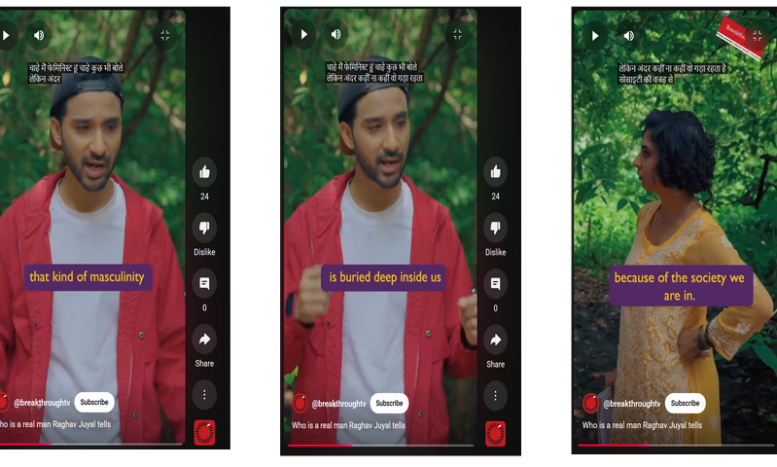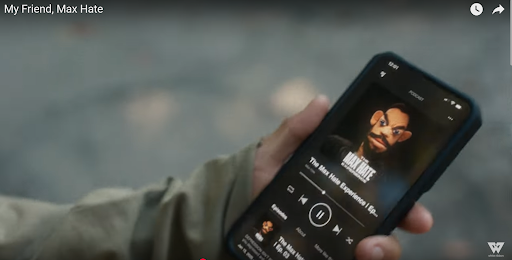7 Tips for calling men and boys in on gender equality through communication campaigns
Lessons from a MenEngage CoLab webinar on transforming gender norms through powerful campaigning. MenEngage CoLab is an initiative of MenEngage Alliance for collective learning about working with men and boys for gender justice.
The rise of backlash against gender equality and the troubling trend of young men embracing online radicalization and political extremism that frames gender equity as a “war on men,” have left many of us asking: What communications messages and approaches can effectively inspire men and boys to join the movement for gender justice in positive and meaningful ways?
To answer this question, members of the MenEngage Global Alliance Global Communications Working Group co-organised the webinar, Reaching Men and Boys: Lessons and Tips from Powerful Campaigns on 25 March 2025. During the webinar Saswati Chatterjee, manager of digital engagement at Breakthrough Trust, India and David Garzon, director of marketing and communications at White Ribbon from Canada, shared how they have been working to design and implement impactful communication and campaign strategies to call in men and boys on gender equality, transform harmful gender norms, and promote positive notions of manhood.
To set the context of the conversation, Tom Hornbrook, Communications Manager at MenEngage Global Secretariat, discussed some of the social and political trends at play:
“Around the world, gender justice is under siege. Everyone is well-aware of the devastating funding for women’s rights, LGBTQI+ rights, sexual and reproductive health, and other critical social justice causes. As MenEngage Alliance, we look at such issues through a men and masculinities lens—or, in other words, we ask what do ideas about being a man have to do with it?”
Tom highlighted several key factors framing the session, including: the rise of far-right movements and governments working to reinstate rigid patriarchal hierarchies; tech billionaires wielding unchecked power over global discourse—shaping what we see and hear while providing space for hate speech to be amplified; online influencers and podcasters who amass vast male audiences with their blends of masculinity, conspiracy theories and freewheeling discussions; and younger men being drawn into narratives of male victimhood, anti-feminism, and outright misogyny and violence.
It is urgent, and essential to the realisation of gender justice for all, to engage men and boys with positive alternatives that challenge rigid and violent notions of manhood. Saswati Chatterjee and David Garzon shared a range of approaches and strategies that Breakthrough Trust and White Ribbon consider key to designing and implementing impactful campaigns. Here are 7 tips for creating campaigns that effectively engage men and boys in challenging harmful gender norms from the session:
1. Authenticity is key
“Young people are desperate to feel something real, something organic from the people they care about.” – Saswati Chatterjee, Breakthrough Trust
“Being able to show the human element of our work is very important…being able to bring different real voices that don’t feel scripted, that feel real and relatable.” – David Garzon, White Ribbon
Both Saswati and David highlighted authenticity—ensuring campaigns resonate and feel relatable—as a crucial element for meaningful, effective campaigning. For Breakthrough, authenticity means basing campaign content on topics that genuinely resonate with young men—”organic conversations,” as Saswati describes them—rather than in messaging that feels forced or contrived.
One way Breakthrough fosters relatability is by collaborating with Bollywood influencers to amplify their messages. Recognising that many young people in India engage with Bollywood in various ways, the organisation asked: why not speak directly through the voices of the figures they admire? By involving cultural figures in conversations about issues like toxic masculinity and domestic violence, Breakthrough taps into audiences who are already listening.

Similarly, White Ribbon prioritises relatability when creating campaigns to call in men and boys for gender equality. David Garzon highlighted that, “addressing relevant topics and making them relatable has been key” for White Ribbon. For example, the organisation’s Men Don’t Want Flowers campaign offers a powerful entry point into conversations about masculinity and vulnerability. By centering the campaign on the widely relatable experience of receiving flowers, it encourages men to reflect on emotional expression and the norms that shape traditional ideas of manhood.
2. Storytelling is important
“I always encourage my colleagues to think about storytelling not just as telling one single story, but as presenting human life as a story. Looking at the diversity of what storytelling is and what it can look like is very key.” – David Garzon, White Ribbon
Storytelling is core to White Ribbon’s campaign strategies. David presented the organisation’s campaign, My Friend, Max Hate, to exemplify how storytelling that hits close to home can make a campaign powerful.
White Ribbon finds it critical to address the current rise in radicalisation, anti-feminist sentiments and the growing influence of the manosphere through creating awareness about the dangers of such harmful ideologies in upfront ways. My Friend, Max Hate, a campaign that “shines a light on how toxic ideologies groom vulnerable boys, clouding their thinking, and turning them into resentful, misogynistic, and often violent men,” does this.

Targeted at parents, educators, and those with youth around them, the campaign tells the story of Shiloh, a young boy struggling with loneliness, bullying, and feeling disconnected, who is misled by watching content from hateful influencers. It presents tools to help caregivers recognise troubling patterns in young people’s behavior, and tools with which to have meaningful conversations with boys in ways that are both direct and engaging.
3. Meeting men and boys where they are
“We have to be very bold and very intentional about what we call men [and boys] to do and also meet them where they are at.” – David Garzon, White Ribbon Canada
To effectively reach young men, gender justice messaging should be present on the platforms they use every day.
Breakthrough found that young men in India mostly get information from platforms like Instagram, YouTube, and through Bollywood. Recognising this, the organisation has digital media as its prominent communication tool, and uses focus group discussions with young people to guide its social media presence. For Breakthrough, leveraging digital media is not just about reaching a demographic—it’s about understanding their world: “What are they watching? What formats do they like? What are the issues that they care about?” Audience-centered approaches enable gender justice messaging to resonate with the daily lives and interests of young men.
White Ribbon found that they had to expand their campaigning beyond YouTube in order to adapt to shifting digital and informational landscapes. In order to expand their reach, the organisation has tailored its campaigns for platforms like TikTok and Instagram by, for example, utilising short, conversational video clips that challenge restrictive gender norms in ways that feel personal, relatable and easily shareable across social media networks.
4. Presenting alternative narratives
Offering positive alternatives to toxic masculinity empowers change and solidifies men’s role in advancing gender justice. Rather than positioning men as ‘problems to be fixed,’ presenting alternatives enables men to see themselves as vital, active, and accountable participants in changing gender norms.
Saswati shared how Breakthrough recognises that the manosphere and extremist influencers often prey on young men’s feelings of loneliness and isolation to fuel misogyny and harmful narratives. Countering this doesn’t mean surveillance—monitoring devices or restricting online spaces—but equipping young men with the tools to discern these narratives for themselves. Breakthrough intentionally showcases stories of men that envision what healthy masculinities could look like in practice—men embracing vulnerability, speaking against violence, and challenging gender norms. Their social media content showcases positive alternatives not as abstract ideals but as tangible actions such as a son confronting an abusive father or boys sharing emotional struggles openly.
For White Ribbon, David discussed how their Men Don’t Want Flowers campaign, and other campaigns they have produced, creatively flip the script on rigid stereotypes about masculinity by: exploring how rigid gender norms harm men and boys too, and by reflecting on how everyday actions—like accepting kindness or expressing emotion—can be powerful acts of self-transformation.
5. Building creative partnerships grounded in transformative values
Building creative partnerships, including by tapping into the emotional power of pop culture, can significantly amplify the reach and impact of gender justice work. Creative alliances that harness the influence of film, music, and digital media are most effective when they stay grounded in transformative values. Also critical to collaboration is partnering with those who authentically align with gender equality goals. When organisations bridge the gap between activism and everyday culture not only do they raise awareness, they also help redefine what is deemed aspirational, acceptable, and normal.
Breakthrough has teamed up with Bollywood stars for candid interviews and talk shows—recognising the colossal influence these celebrities have on shaping young men’s views of masculinity. Through collaborations with filmmakers and digital creators, they have embedded progressive messages into mainstream content, reaching millions and making gender transformation not just relatable, but aspirational.
White Ribbon has also strategically collaborated with influential public figures to further conversations about gender-based violence, and partnered with leading ad agencies to produce powerful campaigns like I Knew All Along, Short Life Stories, and My Friend Max Hate.The organisation engages a wide range of voices for its campaigns—from community leaders to influencers—pushing conversations both onscreen and in offline engagements.
6. Making gender conversations inclusive
Saswati Chatterjee highlighted that core to Breakthrough’s approaches is recognising that gender-based violence, discrimination, and regressive norms impact individuals of all gender identities:
“When we say we talk about gender, we have broken away from speaking about women and girls, and men and boys separately because we recognise that gender-based violence, gender-based discrimination and regressive gender norms have people across the gender spectrum as equal stakeholders and equal allies.”
Both Breakthrough and White Ribbon Canada design their campaigns to reflect diverse lived experiences and expansive understandings of gender. By moving beyond rigid binaries, they create space for more nuanced conversations about power, privilege, protection, and stronger allyship.
7. Navigating backlash: Embracing constructive conflict
Saswati discussed how navigating backlash and embracing constructive disagreement can create opportunities for learning and highlight where audiences may need more clarity.
She spoke about how Breakthrough has responded to criticism for one of their campaigns by intentionally allowing some “slightly provocative” posts to remain visible—not to antagonise, but to create space for genuine dialogue. Rather than dismissing disagreement, Breakthrough engaged in good-faith conversations, asking questions like, “What about this post upset you? Let’s talk about why.” This approach often revealed that beneath the anger were real concerns—and, at times, a willingness to reflect.
This CoLab session highlighted the importance of authenticity, the transformative impact of offering positive and inclusive alternatives, the need to remain adaptable to evolving social contexts, and the value of building aligned creative partnerships in gender justice campaigning efforts. Conversations around how to reach men and boys to transform gender norms through various approaches will continue to be collectively explored within MenEngage spaces. Keep an eye on the MenEngage Alliance social media for future sessions.
Write-up by Aromo Odero, part of the Global Secretariat communications team.
